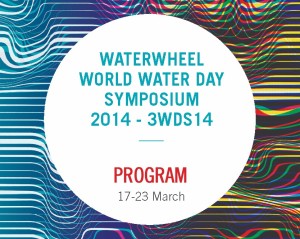 A group of local creatives got together in early 2014 to work towards making a presentation at an online international symposium on water, called Waterwheel World Water Day, about the community’s Lifting the Creek project. They each explored their response to the project, what the creek meant to them and what they would like to see happen. They had weekly meetings to generate and develop ideas and work on a combined presentation.
A group of local creatives got together in early 2014 to work towards making a presentation at an online international symposium on water, called Waterwheel World Water Day, about the community’s Lifting the Creek project. They each explored their response to the project, what the creek meant to them and what they would like to see happen. They had weekly meetings to generate and develop ideas and work on a combined presentation.
Their contribution to the symposium was on the evening of March 21. It was called Putawai: Lifting the Creek. (Putawai translates as the appearance of water.) Hard to imagine now, but back then creating an online symposium was quite an undertaking, and the presentations were restricted to a very small number of megabytes. Some of the original presentations have been lost but below is a sample of what we have managed to preserve.
Postcards to the Creek
Jan and Ella of Hungerford Rd dreamed up an idea called Postcards to the Creek. Postcards were printed and distributed around Houghton Valley and at the school asking people to write a message to the creek in Houghton Valley. The mail box was placed near the small spring opposite the Buckley Reserve Playground for two weeks, and postcards could be mailed there. Over 50 postcards, many from children, with written and drawn personal responses included enthusiasm about the idea of lifting the creek, remembering its past health, the importance of a clean environment, and imaginings of the future clean creek and thriving wildlife.
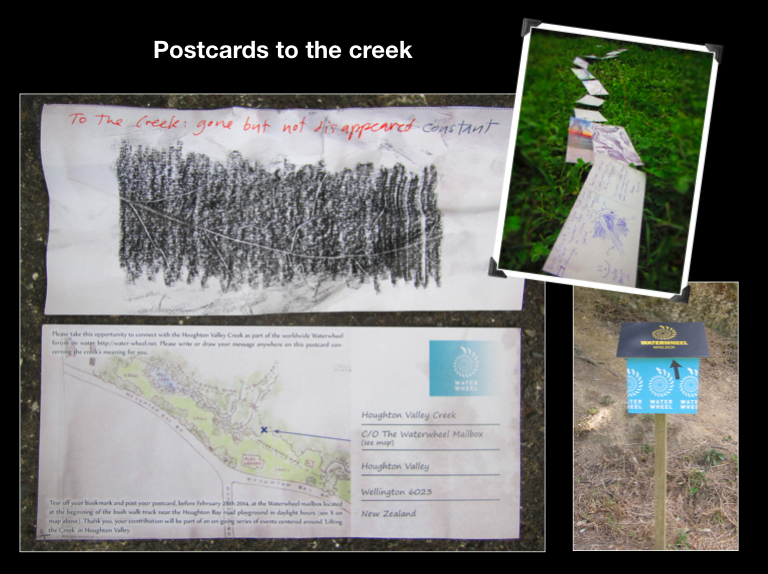
Flow Chart
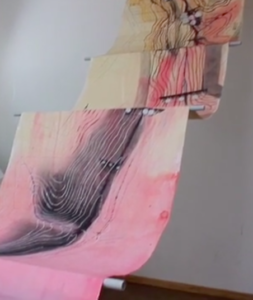 Andrea of View Rd created an installation called Flow Chart. She used the original contoured maps with the landfill design, highlighted and coloured with litmus-like chemical reaction colours. The maps were presented in a continuous stream-like structure. Geoff of Melrose Rd created a video of the individual maps, creating a stream-like presentation through video and audio, as well as documenting Andrea’s installation opening where she invited the community to view it. It was later expanded and installed as an Urban Dream Brokerage project.
Andrea of View Rd created an installation called Flow Chart. She used the original contoured maps with the landfill design, highlighted and coloured with litmus-like chemical reaction colours. The maps were presented in a continuous stream-like structure. Geoff of Melrose Rd created a video of the individual maps, creating a stream-like presentation through video and audio, as well as documenting Andrea’s installation opening where she invited the community to view it. It was later expanded and installed as an Urban Dream Brokerage project.
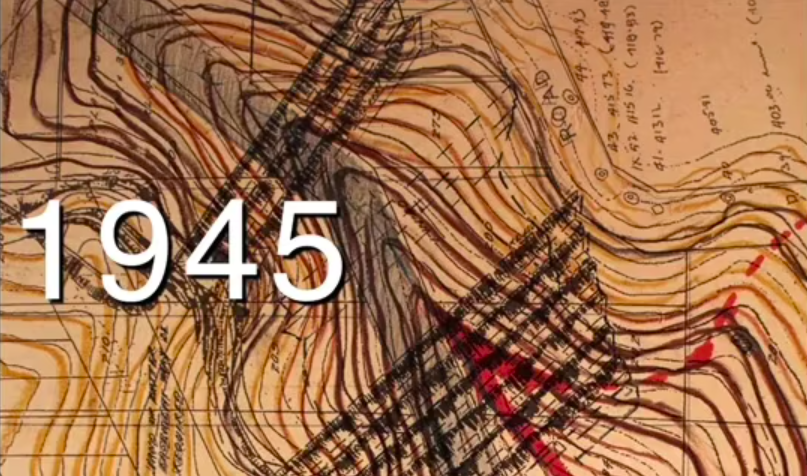
Watch Flow Chart on Vimeo
The Lost Creek
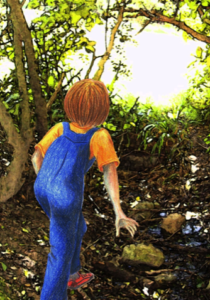 Jenny of Houghton Bay Road dreamed of creating a shared story for the community. Modern neighbourhoods have lost their sense of history – stories of the past – and are unable to connect with each other to share stories of the present. Her project looked at creating a shared story for the future. The story is set as a children’s story as the simplicity of this genre is closer to the myths of old. In her illustrated excerpt, conversations with the stream create a much deeper connection with the nature of water, something that people might fail to see otherwise.
Jenny of Houghton Bay Road dreamed of creating a shared story for the community. Modern neighbourhoods have lost their sense of history – stories of the past – and are unable to connect with each other to share stories of the present. Her project looked at creating a shared story for the future. The story is set as a children’s story as the simplicity of this genre is closer to the myths of old. In her illustrated excerpt, conversations with the stream create a much deeper connection with the nature of water, something that people might fail to see otherwise.
Watch The Lost Creek on Vimeo
Teapot Offerings for the Creek
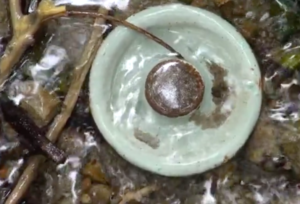 Miranda of Hornsey Rd created an installation of secondhand teapots buried in the spring near the Buckley Reserve Playground, which we afterwards affectionally called Teapot Creek. We wrote offerings to the creek and put them in the teapots. Geoff once again created a great video of the tea ceremony.
Miranda of Hornsey Rd created an installation of secondhand teapots buried in the spring near the Buckley Reserve Playground, which we afterwards affectionally called Teapot Creek. We wrote offerings to the creek and put them in the teapots. Geoff once again created a great video of the tea ceremony.
Watch Teapot Offerings to the Creek on Vimeo
The Wonderful Drama that is Water
Dave of Houghton Bay Rd had over the years collected an amazing collection of photos of the view from his house towards Pencarrow Head and the variety of weather conditions, caused by that greatest of greenhouse gases – water. Geoff dramatised the photos in another match of pictures and music.
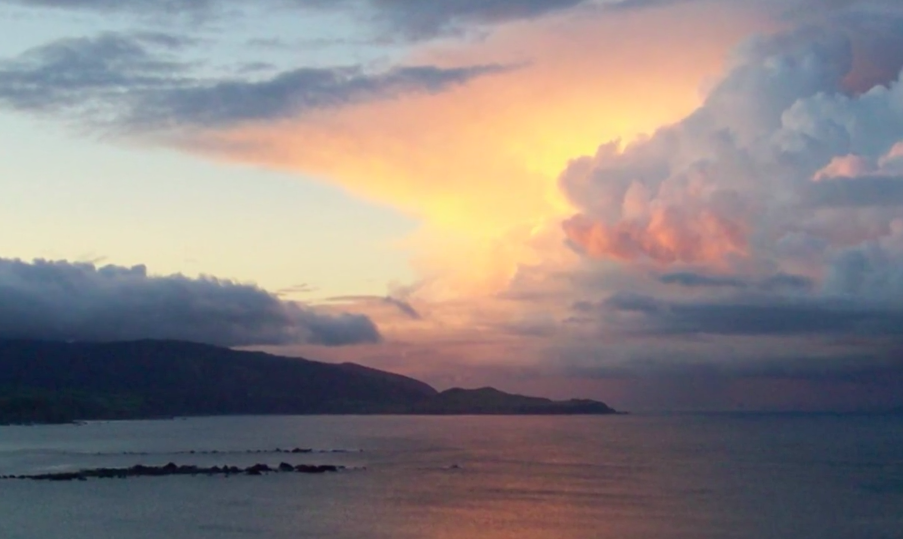
Watch The Wonderful Drama that is Water on Vimeo
Spring Clearing
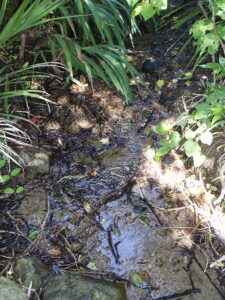
This was a collaborative project started by Jenny of Hungerford Rd to create awareness within the community of the existing freshwater streams in our valley, by weeding and clearing the channels, restoring the bush and creating tracks for people to visit the springs.
As her symposium presentation she reflected: “We are trying to explore a different way of caring for common lands, one that is more akin to indigenous feelings of guardianship. Firstly is to understand that it doesn’t have to be only the job of the authorities: that people can connect with public reserves and look after them the way they would look after their own garden. We have begun to do this in our valley.
Through several sessions we have begun to realise that guardianship works on a deeper level than mere well-meaning working bees. There needs to be a sense of reverence towards the place one is working in, and then the act of tending is more spiritually rewarding, a deeper connection is made. People need also to change the way they perceive the act of caring: it isn’t a duty to be done, it isn’t a time of personal therapy, it isn’t a way of planting your own idea of what is right on the landscape. Having reverence means that you enter the natural world in an open frame of mind. By absorbing the world around you, by noticing and listening to how it is, you can begin to understand what – if anything – needs to be done. Like a child you can be accepting of natural chaos, of what is right, but as an informed adult you can be discerning of the false notes: the rubbish, the blocked energy, the plant species that don’t belong. By entering into the world completely and with all senses receptive to what is around you, you are able for the moment to become the stream, the plants and the wildlife. And by becoming, you can truly understand what is needed.
A spiritual connection with a place does involve some aesthetic intervention as with the spring shrines of old. You naturally wish to enhance the good energy as well as clearing the bad. After removing the weeds, you need to look at what is left – sometimes very little – and introduce more of the right plants to replace them. By studying and understanding the parts that do work, you can replicate that energy by planting the right species in the right place. By creating places for people to appreciate the world they have entered – special views, sitting spaces, tracks, ways to get down to the water – you can create a meaningful interaction between the environment and visitors, and keep them from trampling indiscriminately. The water itself needs to be treated sensitively, understanding natural patterns of channels and pools and leaf litter build-up, and respecting the often hidden wildlife that is there. Clearing excessive debris will enhance the visual impact of the stream; clearing too much could destroy a habitat. Similarly with the bush, open spaces may be more beautiful to a person, but may not be right for the plants or the water.”
Geoff created a video of one of the spring clearing sessions.
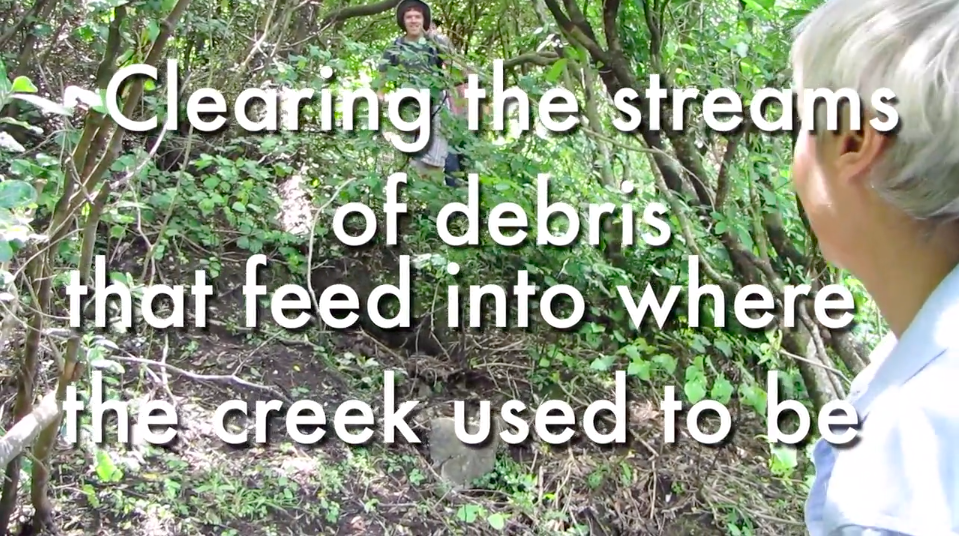
Watch Documenting the Flow on Vimeo
Becoming Creek
Putawai was also our translation for the concept of Becoming Creek, which was an underlying theme for the Waterwheel presentation. Becoming Creek refers to a process, a transition from humans as a dominant species to becoming humans that co-habit with all species. Equity and respect would be a guiding principle. An example is the Whanganui River, which has the same legal rights as a human. In the Haewai / houghton Valley community, Becoming Creek is unfolding at the same time as the lifting of the creek becomes a reality.
And in word play, Becoming Creek can also apply in several ways:
- Becoming Creek: the water that drop by drop and trickle joining into trickle down the hills becomes a creek in the bottom of the valley;
- Becoming Creek: the lost creek that the people in the valley wish to bring back is becoming a reality, initially in imagination and eventually in truth;
- Becoming Creek: the creek that is beautiful;
- Becoming Creek: the people in the valley are collectively identifying with the creek and the distinctions between the community and the creek are dissolving.